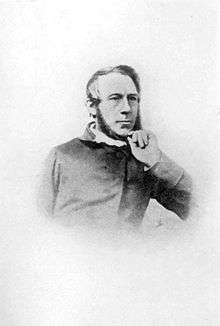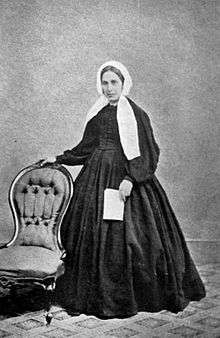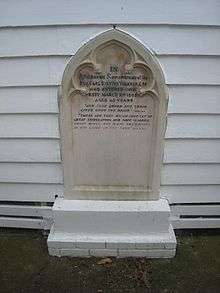Carl Sylvius Völkner
Carl Sylvius Völkner (c. 1819–1865) was a German-born Protestant missionary in New Zealand who was hanged and decapitated at his church grounds on the east coast of the North Island in what became known as the Völkner Incident.
Carl Sylvius Völkner | |
|---|---|
 Carl Sylvius Völkner | |
| Born | c. 1819 |
| Died | 2 March 1865 Ōpōtiki, New Zealand |
| Cause of death | Hanging |
| Burial place | Hiona St Stephen's, Ōpōtiki 38.003683°S 177.284823°E |
| Spouse(s) | Emma Völkner née Lanfear |
Biography
Völkner was born in Kassel, Electorate of Hesse (now Germany) c. 1819 and was one of several missionaries sent to New Zealand by the North German Missionary Society after training at the missionary college at Hamburg.
He arrived in New Zealand in August 1849 and worked initially with fellow German Protestant missionary Johann Riemenschneider, in Taranaki. In 1852 he offered his services to the Church Missionary Society (CMS). For several years he worked as a lay teacher in lower Waikato.[1]

He married Emma Lanfear, sister of a CMS missionary on 29th of June 1854.[2] In 1857, he became a naturalised citizen. Völkner was ordained a deacon in 1860. In 1861, he became a priest and took charge of the CMS mission station at Ōpōtiki in August that year. There he worked among Te Whakatōhea, who built a church and a school for him.
Death
On 19 May 1864 Völkner recorded that four of the 16 Christian teachers of the Ōpōtiki district had accompanied a Pai Mārire (Hauhau) campaign to Maketu, although not as active participants in the fighting.[3] He went to Auckland during 1864 and again in January 1865. He was then warned by members of Te Whakatōhea not to return to Ōpōtiki.[1]
Ignoring the warning, Völkner returned to Ōpōtiki on 1 March 1865 and was apprehended by the Pai Mārire led by Patara, a chief, and Kereopa Te Rau, a Pai Mārire prophet.[1][4] Völkner was hanged the following day from a willow tree near the church by his own Whakatōhea congregation.[1][5] He was taken down and decapitated, and his eyes were gouged out and swallowed by Kereopa Te Rau. The Revd Thomas Grace, who was also in Ōpōtiki, was also taken by the Pai Mārire, although he was rescued.[4]
Legacy

The Anglican church in Ōpōtiki was reconsecrated as St Stephen the Martyr in memory of his death on 21 November 1875. His bible, chalice and paten are still held at the church. After pardon was later granted to those involved in Völkner’s death, the church was renamed again as Hiona St Stephen’s on 5 June 1994[6]
Te Paepae o Aotea, also known the Volkner Rocks, are named after him.
See also
- Völkner Incident
- Christianity in New Zealand
Footnotes
- Stokes, Evelyn (30 October 2012). "Völkner, Carl Sylvius". Dictionary of New Zealand Biography. Wellington, New Zealand: Ministry for Culture and Heritage.
- "MARRIED". Daily Southern Cross (Volume XI, Issue 742). 8 August 1854. Retrieved 5 September 2018.
- "The Church Missionary Gleaner, February 1864". Christian Natives in New Zealand During the Time of War. Adam Matthew Digital. Retrieved 24 October 2015.
- "The Church Missionary Gleaner, September 1865". Death of the Rev. C. S Volkner. Adam Matthew Digital. Retrieved 24 October 2015.
- "Carl Volkner". New Zealand History Online. Wellington, New Zealand: Ministry for Culture and Heritage. 3 March 2014.
- "Hiona St Stephen Memorial, Ōpōtiki". New Zealand History. Ministry for Culture and Heritage. Retrieved 5 September 2018.
References
- Lyall, A. C., (1979) Whakatohea of Opotiki. A.H. & A.W. Reed.
- Chapter 5: The Völkner and Fulloon Slayings, in The Ngati Awa Raupatu Report. Waitangi Tribunal, 1999.
